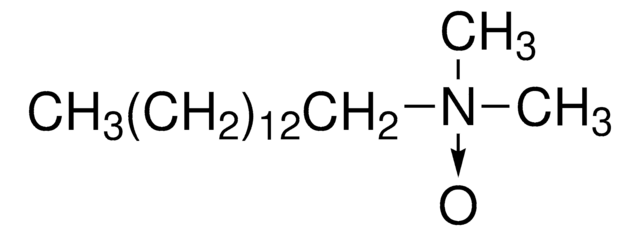Kluczowe dokumenty
40103
N,N-Dimethyldecylamine N-oxide
≥99.0% (NT)
Synonim(y):
1-Decanamine, N,N-dimethyl-, N-oxide, N,N-dimethyldecan-1-amine oxide, DDAO
About This Item
Polecane produkty
opis
non-ionic
Poziom jakości
Próba
≥99.0% (NT)
Formularz
powder
masa cząsteczkowa
201.35 g/mol
zanieczyszczenia
≤0.03% peroxides (as H2O2)
ślady anionów
sulfate (SO42-): ≤50 mg/kg
ślady kationów
Ca: ≤500 mg/kg
Cd: ≤5 mg/kg
Co: ≤5 mg/kg
Cr: ≤5 mg/kg
Cu: ≤5 mg/kg
Fe: ≤5 mg/kg
K: ≤50 mg/kg
Mg: ≤50 mg/kg
Mn: ≤5 mg/kg
Ni: ≤5 mg/kg
Pb: ≤5 mg/kg
Zn: ≤5 mg/kg
temp. przechowywania
2-8°C
ciąg SMILES
CCCCCCCCCC[N+](C)(C)[O-]
InChI
1S/C12H27NO/c1-4-5-6-7-8-9-10-11-12-13(2,3)14/h4-12H2,1-3H3
Klucz InChI
ZRKZFNZPJKEWPC-UHFFFAOYSA-N
Powiązane kategorie
Opis ogólny
Zastosowanie
Hasło ostrzegawcze
Warning
Zwroty wskazujące rodzaj zagrożenia
Zwroty wskazujące środki ostrożności
Klasyfikacja zagrożeń
Eye Irrit. 2 - Skin Irrit. 2 - STOT SE 3
Organy docelowe
Respiratory system
Kod klasy składowania
11 - Combustible Solids
Klasa zagrożenia wodnego (WGK)
WGK 3
Temperatura zapłonu (°F)
Not applicable
Temperatura zapłonu (°C)
Not applicable
Środki ochrony indywidualnej
dust mask type N95 (US), Eyeshields, Gloves
Wybierz jedną z najnowszych wersji:
Masz już ten produkt?
Dokumenty związane z niedawno zakupionymi produktami zostały zamieszczone w Bibliotece dokumentów.
Klienci oglądali również te produkty
Nasz zespół naukowców ma doświadczenie we wszystkich obszarach badań, w tym w naukach przyrodniczych, materiałoznawstwie, syntezie chemicznej, chromatografii, analityce i wielu innych dziedzinach.
Skontaktuj się z zespołem ds. pomocy technicznej










